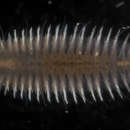Comprehensive Description
provided by Smithsonian Contributions to Zoology
Hololepidella nigropunctata (Horst, 1915)
Polynoe nigropunctata Horst, 1915:20; 1917:104, pl. 21: figs. 15–17.
Allmaniella marquesensis Monro, 1928b:469, figs. 1–4. [New synonymy.]
Malmgrenia marquesensis.—Day, 1962:628; 1967:50, fig. 1.4.p–s.—Intes and Le Loeuff, 1975:273.—Kudenov, 1975b:79
Hololepidella nigropunctata.—Devaney, 1967:287, figs. 1–5; 1974b:154.—Pettibone, 1969a:50, fig. 2a–g.—Gibbs, 1971:117, 120; 1972:203.—Uchida, 1975:19, figs. 1–3.—Amoureux et al., 1978:67, 156.—Sloan et al., 1979:94.—Hendler and Meyer, 1982:742.—Hartmann-Schröder, 1984:66 [key].—Bailey-Brock and Hartman, 1987:234, fig. 3.II.3a–g.—Devaney and Bailey-Brock, 1987:97, 98.—Hanley, 1987:156.
Hololepidella minuta.—Gibbs, 1969:448, 449, fig. 131 [not Polynoe minuta Potts, 1910].
?Harmothoe minuta.—Amoureux et al., 1978:63 [not Polynoe minuta Potts, 1910].
Harmothoe lunulata spp. synaptae.—Amoureux et al., 1978:63 [not Saint-Joseph, 1888].
MATERIAL EXAMINED.—CENTRAL PACIFIC OCEAN: Hawaii: North coast of Oahu, underside of ledge in cave, 7 m, on asteroid Mithrodia sp., 15 Aug 1975, A. Birtles, collector, 1 small specimen (USNM 52793). North shore of Oahu, Pupukea Bay, Beach Park at Kahuku, 2–13 m, sandy pothole, 27 Jul 1976, C. Roper and M. Sweeney, collectors, 1 small specimen (USNM 54147). Marquesas Islands: Tai O Hae Pool, C. Crossland, collector, 6 syntypes of Allmaniella marquesensis (BMNH 1928.1.11.1–3; USNM 45567). Solomon Islands: Graham Point, Marau Sound, on ophiuroids Ophiarthrum elegans Peters and Ophiocoma brevipes Peters, 2 Oct 1965, P.E. Gibbs, collector and identifier, 5 specimens (BMNH 1970.115,118,121,127; USNM 48053).
WESTERN PACIFIC OCEAN: Okinawa: 26°30′N, 127°51′E, 54–57 m, diving, from Ophiuroidea, 14 Mar, 8, 10 Apr 1981, R.F. Bollard, collector, 6 specimens (USNM 100443).
INDIAN OCEAN: Red Sea: Gulf of Elat, from toxic sponge Latrunculia magnifica Keller, 1 specimen (TAV 6928, as H. minuta by Rullier); on solitary coral Fungia scutaria Lamarck, 1 specimen (TAV 9565, as H. lunulata synaptae by Rullier). Mozambique: Inhaca Island, west shore Delagoa Bay, commensal with asteroid Linckia multifora (Lamarck), from J.H. Day, 2 specimens (USNM 45568, as Malmgrenia marquesensis). Australia: Western Australia, Rosemary Island, Dampier, 2 m, on echinoid, 24 Sep 1972, N. Coleman, collector, 1 specimen (AMS W5475).
DESCRIPTION OF SYNTYPES AND SPECIMENS FROM INHACA ISLAND.—Largest complete syntype 9 mm long with 41 segments and 19 pairs of elytra, elytrophores on segments 2, 4, 5, 7, alternate segments to 23, 26, 29, 31, 34, 36, 38, 40. Smallest complete syntype 7 mm long, 37 segments, and 17 pairs of elytra, in similar arrangement. Complete specimen from Inhaca Island with 36 segments and 17 pairs of elytrophores (15 pairs indicated by Day). Elytra oval, darkly pigmented, smooth except for group of microtubercles on anterior region (Figure 2B; Monro, 1928b, fig. 2).
Prostomium bilobed with lobes subtriangular, without distinct cephalic peaks, darkly pigmented except for light areas around 2 pairs of small eyes; ceratophore of median antenna in anterior notch, with long style; ceratophores of lateral antennae inserted terminoventrally, with short styles; palps stout, long, tapered; tentaculophores of first segment lateral to prostomium, each with single seta and pair of dorsal and ventral tentacular cirri (Figure 2A; Day, 1967, fig. 1.4.r).
Parapodia biramous, smaller notopodium with projecting acicular lobe on lower side, larger neuropodium with subtriangular presetal acicular lobe and shorter rounded postsetal lobe (Figure 2C,D; Monro, 1928b, fig. 2; Day, 1967, fig. 1.4.s). Notosetae slightly stouter than neurosetae, with single row of 10–16 widely spaced spines on slightly convex side and abruptly pointed tip (Figure 2E; Monro, 1928b, fig. 3; Day, 1967, fig. 1.4.p). Neurosetae with faint spinose rows, upper ones with longer spinose regions, all with bifid, hooked tip (Figure 2F; Monro, 1928b, fig. 4; Day, 1967, fig. 1.4.q,q′). Dorsal cirri with cylindrical cirrophores on posterior sides of notopodia, with long styles extending to tips of neurosetae or beyond; dorsal tubercles nodular; ventral cirri short (Figure 2D; Monro, 1928b, fig. 2; Day, 1967, fig. 1.4.s).
DESCRIPTION OF YOUNG SPECIMEN FROM CAVE ON OAHU, HAWAII (USNM 52793).—Body in life pinkish orange with pale elytra (noted by A. Birtles, in litt., who collected it on the asteroid Mithrodia sp.). Body flattened, tapered posteriorly, 5.5 mm long, 2 mm wide including setae, with 31 segments. Elytra 15 pairs, on segments 2, 4, 5, 7, then on alternate segments to 23, 26, 29, 31 (small on last small segment). Elytra oval, delicate, transparent, each with group of conical microtubercles on anterior part (Figure 3B).
Bilobed prostomium with subtriangular anterior lobes, without distinct cephalic peaks; ceratophore of median antenna in anterior notch, with style wider basally and with long slender tip; ceratophores of lateral antennae inserted terminoventrally, with short subulate styles; palps long, stout, with filamentous tips; eyes small, 2 pairs; tentaculophores of first segment lateral to prostomium, each with few setae, with pair of dorsal and ventral tentacular cirri similar to median antenna (Figure 3A). Second segment without nuchal fold, with first pair of elytrophores, with biramous parapodia and long ventral buccal cirri similar to tentacular cirri (Figure 3A). Notopodium smaller than neuropodium, rounded basally with digitiform acicular lobe on lower side, aciculum projecting; larger neuropodium with conical presetal acicular upper part with projecting aciculum, rounded lower part, and shorter rounded postsetal lobe (Figure 3C,D). Notosetae, about 15, forming radiating bundle, each with single row of 7–10 widely spaced spines along curved side (Figure 3E). Neurosetae relatively few, about 11, subacicular, with bifid tips and faint spinose rows, upper ones with longer spinose regions than lower ones (Figure 3F). Dorsal cirri with cylindrical cirrophores posterior to notopodia, with long tapered styles extending beyond neurosetae; dorsal tubercles small, nodular; ventral cirri rather large, extending to tip of neuropodium (Figure 3C).
DISTRIBUTION.—Indo-west and central Pacific Ocean. Intertidal to 57 meters.
- bibliographic citation
- Pettibone, Marian H. 1993. "Scaled polychaetes (Polynoidae) associated with ophiuroids and other invertebrates and review of species referred to Malmgrenia McIntosh and replaced by Malmgreniella Hartman, with descriptions of new taxa." Smithsonian Contributions to Zoology. 1-92. https://doi.org/10.5479/si.00810282.538

